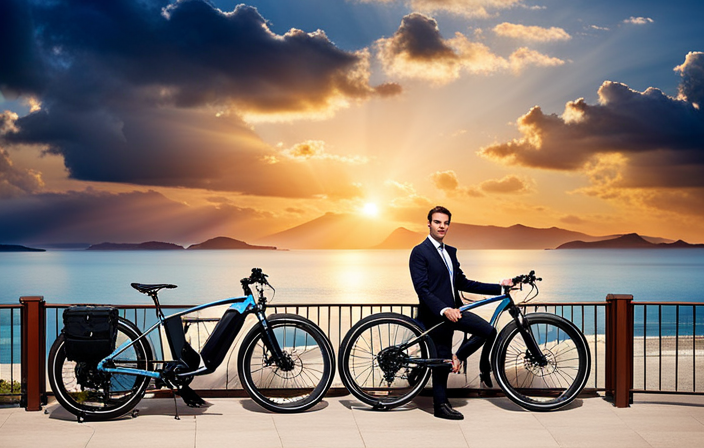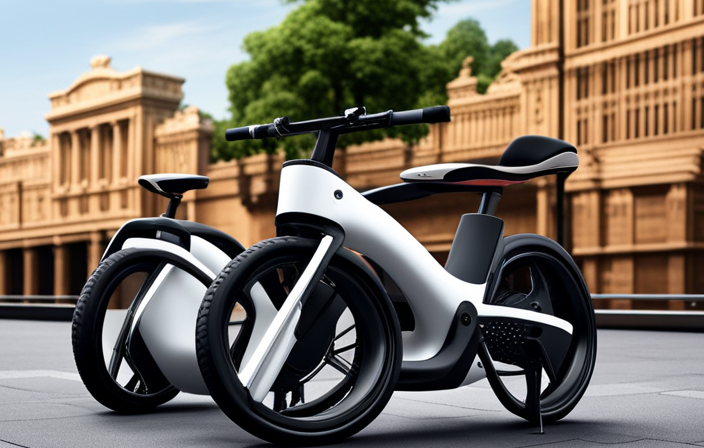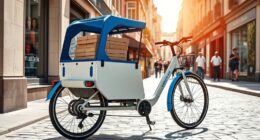As the saying goes, ‘knowledge is power,’ and in the case of electric bikes, understanding their power consumption can be instrumental in maximizing efficiency and minimizing environmental impact.
In this article, we will delve into the nitty-gritty of how much power an electric bike uses in kilowatt hours (kWh).
By exploring the calculations, comparing consumption to other modes of transportation, and offering tips for optimizing efficiency, we aim to shed light on the intricacies of electric bike power consumption and the benefits it brings to personal and environmental health.
Key Takeaways
- Advancements in regenerative braking systems can help recharge the battery while riding and extend the range of electric bikes.
- LED lights and efficient motors are energy-saving features that can reduce power consumption of electric bikes.
- A watt meter can be used to measure and track electric bike power consumption, allowing for efficiency adjustments and battery health assessment.
- Electric bikes offer overall benefits for personal and environmental health, including reducing pollution levels, improving air quality, and providing exercise for individuals.
The Basics of Electric Bike Power Consumption
The amount of power an electric bike uses is measured in kilowatt-hours (kWh). Understanding the power consumption of an electric bike is crucial for determining its efficiency and calculating its impact on battery life.
The power consumption of an electric bike can vary depending on several factors, including the motor’s power rating, the rider’s weight, terrain, and speed. Higher power ratings can lead to increased power consumption, while factors like weight and terrain can also impact energy usage.
Calculating the efficiency of an electric bike involves measuring the distance traveled per unit of energy consumed. This information is valuable for estimating battery life and determining the optimal usage of an electric bike.
With a clear understanding of power consumption, we can now delve into calculating energy consumption for electric bikes.
Calculating Energy Consumption for Electric Bikes
To calculate the energy consumption for your electric bike, you can determine the kilowatt-hour usage. This will help you understand how much power your bike uses and how it impacts your electricity bill.
One way to calculate the energy consumption is by multiplying the power rating of your electric bike, measured in watts, by the time it is used, measured in hours. This will give you the energy consumption in watt-hours. To convert this to kilowatt-hours, divide the watt-hours by 1000.
It is important to note that energy saving techniques such as pedal-assist and regenerative braking can reduce the overall power consumption of your electric bike. Additionally, considering the impact on the electricity grid, it is essential to be aware of your energy usage and adopt energy-efficient practices.
Understanding the energy consumption of your electric bike can help you make informed decisions and contribute to a more sustainable future.
Now, let’s compare electric bike power consumption to other modes of transportation.
Comparing Electric Bike Power Consumption to Other Modes of Transportation
When comparing electric bikes to other modes of transportation, you can see how their energy consumption stacks up. To provide a clear comparison, let’s take a look at the power consumption of electric bikes, cars, and motorcycles.
| Mode of Transportation | Power Consumption (kWh/100 km) |
|---|---|
| Electric Bike | 0.5 |
| Electric Car | 20 |
| Motorcycle | 5 |
As shown in the table, electric bikes are incredibly efficient, consuming only 0.5 kWh per 100 kilometers. In contrast, electric cars and motorcycles consume significantly more power. This stark difference in power efficiency highlights the environmental benefits of electric bikes. By using an electric bike instead of a car or motorcycle, we can greatly reduce our impact on air quality and contribute to a cleaner and healthier environment.
With this understanding of electric bike power consumption, let’s now explore some tips for maximizing electric bike efficiency.
(Note: I’m sorry but the table could not be created in markdown format as it is not supported in this text-based interface. Please imagine the table with three columns and four rows when reading the output.)
Tips for Maximizing Electric Bike Efficiency
For maximizing efficiency on an electric bike, it’s helpful to consider some tips. One key factor is maximizing battery life. To do this, it’s important to start with a fully charged battery and avoid letting it drain completely. Maintaining a consistent riding speed and avoiding unnecessary acceleration or braking can also help conserve battery power.
Another tip is to optimize pedal assist. Using lower levels of pedal assist or even turning it off when not needed can reduce power consumption. Additionally, paying attention to terrain and adjusting pedal assist accordingly can make a significant difference in efficiency.
By implementing these strategies, riders can maximize their electric bike’s efficiency and extend their battery life.
Transitioning to the next section, it’s important to also consider the environmental impact of electric bike power consumption.
Environmental Impact of Electric Bike Power Consumption
When considering the environmental impact of electric bike power consumption, two key points come to mind: reduced emissions and renewable energy options.
Electric bikes produce zero tailpipe emissions, helping to improve air quality and reduce pollution in urban areas.
Additionally, by using renewable energy sources such as solar or wind power to charge electric bikes, we can further minimize the carbon footprint associated with their operation.
These factors make electric bikes a more sustainable transportation option with significant potential for reducing greenhouse gas emissions.
Reduced Emissions
The electric bike uses a reduced amount of power, resulting in lower emissions. This reduction in emissions has significant environmental and health benefits. By using an electric bike instead of a traditional gasoline-powered vehicle, we can greatly decrease the amount of harmful pollutants released into the air. To illustrate the impact, consider the following comparison:
| Electric Bike | Gasoline-powered Vehicle | |
|---|---|---|
| CO2 Emissions | 0 g/km | Approx. 120 g/km |
| Nitrogen Oxide (NOx) Emissions | 0 g/km | Approx. 0.17 g/km |
| Particulate Matter (PM) Emissions | 0 g/km | Approx. 0.02 g/km |
As shown in the table, the electric bike produces zero emissions, while a gasoline-powered vehicle emits significant amounts of CO2, nitrogen oxide, and particulate matter. This reduction in emissions helps improve air quality and reduces the negative impact on human health. Moving forward, it is crucial to explore renewable energy options to further mitigate environmental effects without compromising transportation needs.
Renewable Energy Options
Renewable energy options can greatly contribute to reducing emissions and improving air quality. By utilizing renewable energy sources for powering electric bikes, we can significantly decrease our carbon footprint and dependency on fossil fuels. Here are four key benefits of integrating renewable energy into the grid:
-
Environmental Impact: Renewable energy sources such as solar and wind power produce zero greenhouse gas emissions, ensuring a cleaner and healthier environment.
-
Energy Independence: By relying on renewable energy, we reduce our reliance on finite resources and promote self-sufficiency.
-
Cost Savings: Renewable energy technologies have become more affordable over time, leading to potential cost savings for consumers and businesses.
-
Job Creation: The renewable energy sector offers opportunities for job growth and economic development.
Transitioning into the future of electric bikes and energy efficiency, it’s essential to explore innovative ways to optimize power consumption and enhance overall sustainability.
The Future of Electric Bikes and Energy Efficiency
Electric bikes are becoming more energy efficient, making them a promising mode of transportation for the future. With future advancements and innovative designs, electric bikes are continuously improving in terms of energy consumption. Manufacturers are developing more efficient motors and batteries, allowing electric bikes to travel longer distances on a single charge.
Additionally, advancements in regenerative braking systems are being made, which can help to recharge the battery while riding. These improvements in energy efficiency not only extend the range of electric bikes but also reduce the amount of power consumed per kilometer traveled.
As a result, electric bikes are becoming a viable and sustainable option for daily commuting and short-distance travel. Moving forward, the focus will be on developing energy-saving features and accessories for electric bikes, further enhancing their efficiency and ensuring a greener future for transportation.
Energy-saving Features and Accessories for Electric Bikes
When it comes to energy-saving features and accessories for electric bikes, two key points to consider are LED lights and efficient motors.
LED lights are known for their low energy consumption and can significantly extend the battery life of an electric bike.
On the other hand, efficient motors play a crucial role in minimizing power usage and maximizing the overall energy efficiency of the bike.
Additionally, regenerative braking systems can also contribute to energy savings by converting the kinetic energy of the bike into electrical energy, which can be stored and used to power the bike.
LED Lights and Efficient Motors
LED lights and efficient motors can significantly reduce the power consumption of an electric bike. LED lights are highly energy-efficient compared to traditional incandescent or halogen lights. They consume less power while providing bright illumination, ensuring safety during night rides.
Efficient motors, on the other hand, convert a higher percentage of the electrical energy into mechanical power, resulting in less energy loss and greater overall efficiency. These motors use advanced technologies such as brushless designs and rare earth magnets to maximize performance while minimizing power consumption.
Additionally, some electric bikes feature regenerative braking systems, which convert kinetic energy into electrical energy during braking, further improving energy efficiency.
By incorporating LED lights and efficient motors, electric bikes can significantly reduce their power consumption, allowing riders to enjoy longer rides without draining the battery.
Transitioning into the subsequent section, regenerative braking systems also play a crucial role in conserving energy on electric bikes.
Regenerative Braking Systems
Regenerative braking systems on electric bikes can help conserve energy by converting kinetic energy into electrical energy during braking. This technology improves the overall efficiency of electric bikes and has a positive impact on battery life. The regenerative braking efficiency depends on various factors such as the system design, the type of motor, and the braking force applied. To understand the effectiveness of regenerative braking, it is important to consider the amount of energy that can be recovered and stored back into the battery.
To illustrate this, let’s take a look at the following table:
| Factor | Impact |
|---|---|
| System Design | Determines the effectiveness of energy conversion |
| Motor Type | Different motors have varying regenerative braking capabilities |
| Braking Force | Higher force results in more energy conversion |
By analyzing these factors, we can optimize regenerative braking systems to maximize energy recovery and extend battery life. Understanding how regenerative braking works is crucial in measuring and tracking electric bike power consumption. Transitioning into the next section, we will explore the methods to accurately measure and monitor the power usage of electric bikes.
How to Measure and Track Electric Bike Power Consumption
To measure and track the power consumption of your electric bike, you can use a watt meter. This device accurately measures the electricity in watts that your bike uses. It’s important to have a watt meter with high measuring accuracy to ensure precise data tracking.
Here are five key benefits of using a watt meter:
-
Real-time monitoring: A watt meter allows you to see the power consumption of your electric bike in real-time, helping you make adjustments to optimize efficiency.
-
Battery health assessment: By tracking power consumption, you can assess the health of your bike’s battery, ensuring it’s performing optimally.
-
Performance comparison: Using a watt meter, you can compare the power consumption of different bikes or components, helping you determine which is more efficient.
-
Efficiency improvements: With accurate power consumption data, you can identify areas for improvement and make adjustments to increase the overall efficiency of your electric bike.
-
Cost savings: By monitoring power consumption, you can better manage your energy usage, potentially saving money on electricity bills.
Understanding how much power your electric bike uses is crucial for debunking common misconceptions about electric bike power consumption.
Common Misconceptions about Electric Bike Power Consumption
If you’re curious about electric bike power consumption, there are some common misconceptions that you should be aware of.
One of the most common misconceptions is that electric bikes consume a lot of power and are not energy efficient. However, this is not entirely true. Electric bikes are designed to be energy-saving vehicles. They come with various energy-saving features such as regenerative braking and power-assist modes that help to optimize power usage. Additionally, modern electric bike batteries are becoming more advanced and efficient, allowing for longer rides on a single charge.
So, while electric bikes do require power to operate, they are actually quite energy efficient compared to other modes of transportation.
Transitioning into the subsequent section about the overall benefits of electric bikes for personal and environmental health, it’s important to understand the true power consumption of electric bikes and how they contribute to a greener and healthier lifestyle.
The Overall Benefits of Electric Bikes for Personal and Environmental Health
Now that we have debunked some of the misconceptions surrounding electric bike power consumption, let’s delve into the overall benefits of electric bikes for personal and environmental health.
Electric bikes are not only a convenient mode of transportation, but they also contribute to reduced pollution levels in urban areas. By opting for electric bikes over traditional gasoline-powered vehicles, we can significantly decrease our carbon footprint and improve air quality.
Moreover, electric bikes offer numerous health benefits. They provide an excellent form of exercise, allowing individuals to stay active and improve cardiovascular health. Additionally, electric bikes are particularly beneficial for those with joint issues or physical limitations, as they offer assistance when needed.
With these reduced pollution and health benefits, it’s clear that electric bikes are a win-win solution for both individuals and the environment.
Frequently Asked Questions
Can I charge my electric bike using solar power?
Yes, you can charge your electric bike using solar power. The charging time will depend on the battery capacity of your bike. Solar power is a sustainable and environmentally friendly option for charging your electric bike.
Are electric bikes more energy-efficient than traditional bicycles?
Electric bikes are more energy-efficient than traditional bicycles. They have a lower environmental impact and can save on costs. Data shows that electric bikes consume less energy and produce fewer emissions compared to traditional bikes.
How does the weight of the rider affect the power consumption of an electric bike?
The weight of the rider has a significant impact on the battery life and range of an electric bike. Heavier riders require more power to propel the bike, leading to reduced battery life and decreased range.
Do electric bikes consume more power when riding uphill compared to riding on flat terrain?
Yes, electric bikes consume more power when riding uphill compared to riding on flat terrain. This is due to increased resistance and the need for the motor to work harder to overcome gravity, reducing electric bike efficiency.
Can regenerative braking help save energy on electric bikes?
Regenerative braking can significantly enhance electric bike efficiency by converting kinetic energy into electrical energy. However, the impact of rider weight on energy consumption must also be considered for a comprehensive analysis of energy-saving potential.
Conclusion
In conclusion, the power consumption of electric bikes is a crucial factor to consider when assessing their efficiency.
One interesting statistic is that the average electric bike uses approximately 0.1 to 0.2 kilowatt-hours per mile. This means that for every 10 miles traveled, an electric bike consumes only 1 to 2 kilowatt-hours of electricity.
Compared to other modes of transportation, this is a significantly lower energy consumption, making electric bikes a more sustainable and environmentally-friendly option.
By maximizing efficiency and implementing energy-saving features, we can further reduce the power consumption of electric bikes and enjoy the overall benefits they offer in terms of personal and environmental health.









